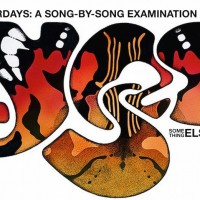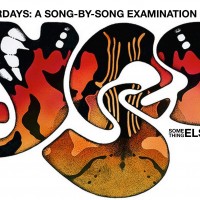Here’s a look back at a handful of early songs that pointed the way from Yes’ often-overlooked self-titled debut, released on July 25, 1969:
‘BEYOND AND BEFORE’
Yes has long been in a state of perpetual change. That starts with the band’s 1969 self-titled debut, a promising blend of jazz, rock and folk that only hints at the greatness to come.
They would, of course, jump light years ahead with 1971’s The Yes Album, but only after beginning a series of personnel changes. That said, Yes — which begins with “Beyond and Before” — still sounds as fresh and adventuresome as it did in 1969, if not quite like the classic Yes to come.
You’ll hear hints of the best-known sound put forth by the lineup of Jon Anderson, Chris Squire, Steve Howe, Rick Wakeman and Alan White in this leadoff song, but “Beyond and Before” — composed by bassist Squire and writer Clive Bailey — actually owes more to the psychedelic bands of the era than the precise, almost classically driven latter-day Yes masterworks.
Credit for that goes to original Yes guitarist Peter Banks, who creates the defining element of this song with his twangy and aggressive approach. His distorted and aggressive playing differs dramatically from his Yes successor Steve Howe (or Trevor Rabin and Billy Sherwood, for that matter). The former Mabel Greer’s Toyshop guitarist always sounds as if he’s about to fly off the rails.
Still, Peter Banks’ approach perfectly complements Chris Squire’s aggressive bass work — which, even in this early example, is innovative and well, progressive. Equally effective is the jazz-inspired, deeply nuanced playing of drummer Bill Bruford. Always the epitome of taste, Bruford makes his minimalist drum set sing. Meanwhile, Tony Kaye’s Hammond organ never intrudes, interacting perfectly with the rhythm section.
What’s missing? Yes singer Jon Anderson (another Mabel Greer’s Toyshop alum) is relegated to a harmony role with Squire, and doesn’t make himself fully known just yet. One of the things that help forge the Anderson/Squire partnership was the duo’s love of harmony. On Yes’ “Beyond and Before,” that love is displayed — and we all know the partnership will lead to many more fantastic vocal interactions and classic songs. Even though this is only 1969, Yes is already hinting at great things to come.
‘I SEE YOU’
Here’s another hint of what’s to come from Yes’ self-titled debut, but there are also many tentative elements remaining. A Byrds cover written by Roger McQuinn and David Crosby, “I See You” is likely best remembered as a indicator of Yes’ early interest in humble folk rock. There’s more to it than that, however.
Founding Yes drummer Bill Bruford provides a driving and nuanced drum foundation, which may well be the highlight of the track. His cymbal and snare work are hardly common rock fare as he plays on top of the kick — using the ride cymbal as effectively as many of his jazz brethren. Tony Kaye also shows his meddle with manic Hammond sweeps and stabs.
Still, it’s hard to believe this is the same band that would soon compose and play “Yours Is No Disgrace.” By then, of course, Yes had moved on without guitarist Peter Banks, whose multi-colored lead and solo push “I See You” from folk rock to psychedelic rock, and back. Banks is explosive, exciting and dangerous.
It might seem that the combination of these many elements would make “I See You” a little awkward, but they are somehow combined into an offbeat, if decidedly “un-Yes-like” whole.
Credit Jon Anderson and Chris Squire. “I See You,” a wild experiment in folk psychedelia, is ultimately held together by Anderson’s vocal prowess, and Squire’s brotherly harmony and driving bass, both of which push the song over the top. Yes, indeed.
‘LOOKING AROUND’
Jon Anderson and Chris Squire collaborated elsewhere with Bill Bruford and Clive Bailey, but “Looking Around” stands apart. It’s the first of their duo compositions to appear on a Yes album.
The track opens with Tony Kaye’s swirling organ, deftly supported by an aggressive Bill Bruford beat. Squire and guitarist Peter Banks provide powerful backing vocals to the track, and their support there is far different than the Yes choir we have come to know and love. Banks’ sense of harmony is very much similar to that of Squire’s — giving the song a folky/pop sheen.
Banks’ guitar, on the other hand, is more psychedelic than current Yes fans are used to. Jon Anderson sings lower in his register than we are used to hearing, as well, and it fits the song perfectly.
The entire band shines in their individual contributions, as “Looking Around” is propelled forward by Kaye’s jaunty organ stabs. The song would have easily been a stand-out track on a Mabel Greer’s Toyshop album, and makes a fascinating footnote in Yes’ catalog. It’s an early stand-out moment for the then-fledgling band.
‘HAROLD LAND’
Side 2 of Yes’ self-titled 1969 debut begins with “Harold Land,” a promising-but-still-transitional composition from Jon Anderson, Bill Bruford and Chris Squire.
The song’s introduction provides a hint of the progressive future of the band, but the lyrics — which are about the impact of war on the named character — show that Anderson has a little way to go before becoming the wordsmith he would demonstrate starting with The Yes Album. Also, the lyrics have nothing to do with the late jazz saxophonist of the same name.
“Harold Land” has many elements for a modern-day Yes fan to like, however. Squire gets thinks kicked off on bass, working expertly with Bill Bruford’s shuffle. Tony Kaye gives Yes fans plenty to smile about. His Hammond B-3 organ pumps and surges along, heightening the complex interplay between Chris Squire and Bill Bruford. In short order, Peter Banks joins in with an angular guitar lead, which almost approaches Tony Kaye’s organ intro in intensity.
At 50 seconds, the Yes choir comes in with a harmony “aaaaahh” — setting up the next section of the song and signaling a nice time change. Unfortunately, things slow as Jon Anderson tells the story of the solder Harold Land in a rather conventional narrative. The song attempts to recapture the earlier intensity with the building backing vocals, but even with the increased pace and some nice piano passages from Tony Kaye, it suffers under the weighty lyrics.
“Harold Land” is a good song, but today can be seen simply as a preface of things to come from the world’s greatest progressive rock band.
‘SURVIVAL’
Yes knows a thing of two about survival. It’s doubtful than anyone in the Yes camp — or the music industry for that matter — expected the band to be around too much after this 1969 debut, much less go through so much perpetual change. As such, it seems only fitting that the last song on the initial recording by Yes is titled “Survival.”
This Jon Anderson composition has many familiar Yes elements, such as tight harmonies between Anderson, Peter Banks and Chris Squire, pulsating organ flourishes by Tony Kaye and an adventurous, distorted guitar opening. Throughout, Bill Bruford provides a jazzy, ride cymbal centered back beat. The instrumental introduction is progressive in nature, but when the main theme kicks in the song becomes more conventional.
“Survival” is a song from a band still tentative in its prog leanings — though, lyrically, Jon Anderson is, well, Jon Anderson. “Sunshine is creeping in and somewhere in a field a life begins; an egg too proud to rape,” he sings. “The beginning of a shape of things to come that starts the run; life has begun — fly fast the gun.”
Interesting stuff, if not fully backed, and a promising end to the debut album. Yes would go on, the following year, to release Time and a Word. Change was already in the air, as that album marks the last with the original lineup.
- The Blackbyrds – ‘City Life’ (1975; 2025 reissue) - June 9, 2025
- Fernando Perdomo – ‘Waves 6’ (2025) - June 8, 2025
- Thelonious Monk – ‘Thelonious Himself’ (1957; 2025 vinyl reissue) - May 26, 2025



